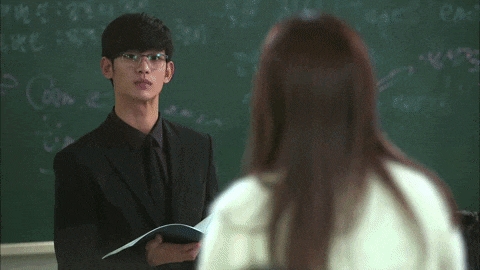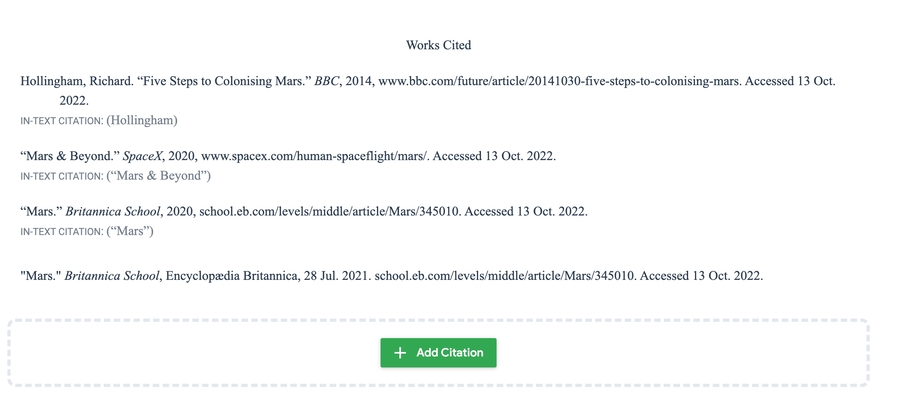
Whenever you paraphrase, quote or use information or ideas from a source, you need to include an in-text citation so that anyone reading your work can easily find the original source of the information.
Use in-text citatations to
give credit to the authors of the sources you have used.
increase the credibility of your argument
avoid plagiarism
You can use MyBib to find what your in-text citation should include, but this will only work if you have added the correct author's name.
MyBib will suggest the in-text citations for your sources, but these will only be correct if you have included the correct author and article title in your reference.
Your in-text citation will always be either the last name of the author, or the name of the article (in quotation marks).
Your in-text citations will never be a website name
Your in-text citations should never be in italics
You should not use a URL inside an in-text citation
If you are citing multiple works by the same author, identify which source you are citing from by including a comma after the author’s name, followed by the title (or a shortened version of the title) e.g. (Austen, Pride ).
For 2 authors, list both authors in the in-text citation:
e.g. (Lin and Lan)
Work Cited
Lin, Tsun-Ju, and Yu-Ju Lan. “Language Learning in Virtual Reality Environments: Past, Present, and Future.” Journal of Educational Technology & Society, vol. 18, no. 4, 2015, pp. 486–497. JSTOR, www.jstor.org/stable/jeductechsoci.18.4.486.
For 3 or more authors, list the the first authorfollowedd by et al.:
e.g. (Yang et al.)
Work Cited
Yang, Fumeng, et al. “A Virtual Reality Memory Palace Variant Aids Knowledge Retrieval from Scholarly Articles.” IEEE Transactions on Visualization and Computer Graphics, 2020, pp. 1–1, 10.1109/tvcg.2020.3009003. Accessed 4 Mar. 2021.
In-text citations should usually be placed at the end of a sentence.
Manga scholar Mike Hill notes that "the influence of Disney can be seen in the character designs and storytelling techniques used in many manga" (34).
If you quote or paraphrase from two different pages in the same source you can include these in one in-text citation, separated by a colon:
In the period from 1979 to 1999, Hong Kong's film production averaged 133 films annually, while the mainland made less than 100 films per year in the 1980s (127; 134).
If you quote or paraphrase from different sources in one sentence, you can also include these in one in-text citation, separated by a colon:
In a recent study, it was found that "music can have a positive impact on memory recall" and this has been subsequently backed up by research (Green 67; Wang 89).
If you quote or paraphrase from different sources in one sentence, you can place the in-text citation directly after the quotations if needed to link the quotation more clearly to the correct source. You can also do this to clearly distinguish your ideas from those of others.
According to Yip, video game arcades were a common sight in the city (45), while Mak makes the point that "people of all ages were flocking to arcades" (211).
Full-stop should appear after the in-text citation (after the last bracket).
Punctuation such as a full-stop should appear after the brackets of the citation, not inside the previous sentence or quote:
This example is incorrect:
" ... without considering the forces that cause them to move." (Whittaker)
This example is correct:
" ... without considering the forces that cause them to move” (Whittaker).

In general is is a good idea to paraphrase rather than quote, as this makes it easier to express your own thoughts and ideas regarding the source material you are discussing. Use quotes sparingly, and avoid using them as a way to bump up your word count.
You might want to consider using quotes when:
a unique term or phrase is used
you are providing a definition
you are discussing the specific language used in the source, rather than the content
you might alter the meaning of the original source significantly by paraphrasing it
the source material is already famous as a quote
Quotations should not appear by themselves, but should rather be incorporated into a sentence by using a signal phrase such as:
“According to X”, “Y states that … ”, “Z observes that ...”.
More Signal Phrases Here
You can use a source that has been cited by another author if you need to, but it is best to try and find the original source if possible. If you are not able to find the original source use the abbreviation qtd. in (“quoted in”).
According to Green (qtd. in Matheson 132), the degree of …..
The MLA Handbook advises that “when a quotation is directly followed by a parenthetical citation … any required comma or period follows the citation” (88).
While you may need to include quotes more often that in other subjects, make sure that you:
avoid using block quotes unless absolutely needed e.g. you are closely analysing the language used in the entire quote.
avoid padding out your word limit with long block quotations, which will mean that you will struggle to make a strong argument within the word limit.
don't use quotes to just summarise the narrative.
Present your argument and analysis of the text, support it with evidence in the form of a paraphrase or quote if needed, and then discuss how this evidence supports your argument and analysis.
If a quotation is not longer than four lines, you should “put it in quotation marks and incorporate it into the text” (75). When quoting a block of text that is longer than four lines, you should indent the quote by 1.25cm. This is known as a block quote. When using a block quote you do not need to include quotation marks.
For example, if you were to include the following long quote from 1984, you would format it as follows (note the in-text citation appears after the full-stop) :
So completely did they dwarf the surrounding architecture that from the roof of Victory Mansions you could see all four of them simultaneously. They were the homes of the four Ministries between which the entire apparatus of government was divided. The Ministry of Truth, which concerned itself with news, entertainment, education, and the fine arts. The Ministry of Peace, which concerned itself with war. The Ministry of Love, which maintained law and order. And the Ministry of Plenty, which was responsible for economic affairs. Their names, in Newspeak: Minitrue, Minipax, Miniluv, and Miniplenty. (Orwell 10)
Ellipsis and Other Alterations
Whenever you alter a quotation by removing words, use an ellipsis to indicate that words have been omitted. This indicated in your writing by 3 periods, preceded and followed by a space ( … ).
If you need to alter a quote by inserting text, indicate this using [square brackets].
MLA Handbook. Modern Language Association Of America, 2021.
Orwell, George. 1984. Houghton Mifflin Harcourt, 2013.

Decide on keywords to use for research.
Choose the best place to look for information e.g. Britannica, the Library, Google.
Skim read results pages and find sources with information relevant to your research.
Paraphrase the relevant information from each source into your notes doc and add a url for each source.
If copying and pasting useful material to quote later, use “colour and quotes” to identify it as copied.
Add paraphrased material into assignment and add it to MyBib so that you can later add it to your Works Cited page.
Read the text that you are paraphrasing carefully until you really understand it. You might need to reread several times
Are there any words e.g.nouns you can’t change?
Try and remember the text without looking at it. Close the tab in your browser or switch to another tab. Don’t switch back to the original until you have finished.
Paraphrase the text aloud with a partner if possible, or imagine doing this. Use your own words, like telling a story. Write your paraphrase down in your notes with a reference or URL so that you can find it again later.
Source: , Episode 2, 2013
Read & Reread
Rethink
Restate
Rearrange
Do you do this? Have you ever done this before, or have you done some of these things? Be honest!
Copy and paste assignment question into Google
Click on the first link on the results page (usually wikipedia)
Copy and paste useful paragraphs to a Google Doc that you call “Notes”
Copy some useful paragraphs to final assignment document
Use these techniques to paraphrase more complicated technical texts.
Combine sentences.
Remove details that are not relevant.
Change sentence structure.
Change voice.
If you are using Google Slides or Powerpoint, you still need to acknowledge all your sources using in-text citations and a works cited page.
Sources can be acknowledged in an oral presentation using a signal phrase e.g.: "According to a May 2022 article form The Economist, ....."
If you need to quote a source directly you can use the words “quote … unquote” or you can use air quotes.
Your teacher may also ask you to submit a works cited page with your oral presentation.
Check your paraphrase with the original text. Is the meaning the same?
Review
Change a few words to synonyms
Make a Works Cited page with some websites that look good and hand it in
Use synonyms. Note that only replacing a few words for synonyms is not paraphrasing.


